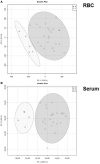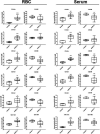Activation of Sphingomyelinase-Ceramide-Pathway in COVID-19 Purposes Its Inhibition for Therapeutic Strategies
- PMID: 34987511
- PMCID: PMC8721106
- DOI: 10.3389/fimmu.2021.784989
Activation of Sphingomyelinase-Ceramide-Pathway in COVID-19 Purposes Its Inhibition for Therapeutic Strategies
Abstract
Effective treatment strategies for severe coronavirus disease (COVID-19) remain scarce. Hydrolysis of membrane-embedded, inert sphingomyelin by stress responsive sphingomyelinases is a hallmark of adaptive responses and cellular repair. As demonstrated in experimental and observational clinical studies, the transient and stress-triggered release of a sphingomyelinase, SMPD1, into circulation and subsequent ceramide generation provides a promising target for FDA-approved drugs. Here, we report the activation of sphingomyelinase-ceramide pathway in 23 intensive care patients with severe COVID-19. We observed an increase of circulating activity of sphingomyelinase with subsequent derangement of sphingolipids in serum lipoproteins and from red blood cells (RBC). Consistent with increased ceramide levels derived from the inert membrane constituent sphingomyelin, increased activity of acid sphingomyelinase (ASM) accurately distinguished the patient cohort undergoing intensive care from healthy controls. Positive correlational analyses with biomarkers of severe clinical phenotype support the concept of an essential pathophysiological role of ASM in the course of SARS-CoV-2 infection as well as of a promising role for functional inhibition with anti-inflammatory agents in SARS-CoV-2 infection as also proposed in independent observational studies. We conclude that large-sized multicenter, interventional trials are now needed to evaluate the potential benefit of functional inhibition of this sphingomyelinase in critically ill patients with COVID-19.
Keywords: FIASMA; ceramide; drug repurposing; molecular biology of critical care; molecular markers; organ failure; sphingomyelinase.
Copyright © 2021 Abusukhun, Winkler, Pöhlmann, Moerer, Meissner, Tampe, Hofmann-Winkler, Bauer, Gräler and Claus.
Conflict of interest statement
The authors declare that the research was conducted in the absence of any commercial or financial relationships that could be construed as a potential conflict of interest.
Figures




References
Publication types
MeSH terms
Substances
LinkOut - more resources
Full Text Sources
Medical
Research Materials
Miscellaneous

